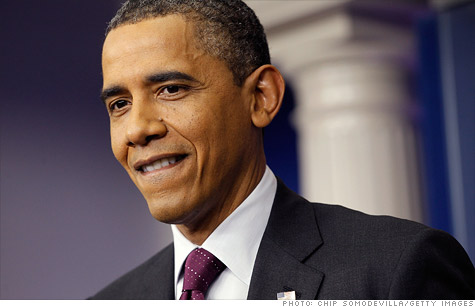Search News

I would like a lower unemployment rate, please.
NEW YORK (CNNMoney) -- The economy added 227,000 jobs in February, but the unemployment rate didn't change at all.
Woe is the White House -- which would love to have the lowest rate possible heading into the general election.
But why didn't the unemployment rate change if the economy added jobs?
The unemployment rate measures the percent of the labor force that is unemployed.
The unemployed are individuals who have actively looked for work over the previous four weeks. Looking for work can mean having a job interview, sending out resumes, or even something as simple as calling friends or relatives in hopes of finding a job.
The number of unemployed is then divided by the total labor force. And in February, the size of the labor force increased -- possibly as discouraged workers started looking for work again.
As the labor force swelled, so did the number of new jobs necessary to drop the unemployment rate.
Just take a look at the last two months for an example of how this works.
In February, 227,000 jobs were added and the unemployment rate didn't change. Compare that to January, when the economy added 243,000 jobs and the unemployment rate dropped from 8.5% to 8.3%.
The difference?
In January, the labor force participation rate decreased by 0.3%. In February, it increased by 0.2%.
And that 0.2% increase in February translated to 476,000 extra people in the labor force, preventing a decline in the unemployment rate.
So it's possible that an improving economy can actually cause the unemployment rate to remain static, or even rise, as more discouraged workers start mailing resumes.
Much has been made of how low -- or high -- the unemployment rate might be on Election Day, and whether a particular number will be enough to ensure a victory for President Obama, or sink his candidacy.
Of course, the unemployment rate is not the best measure of economic strength, but the number plays a large role in campaign trail rhetoric.
Assuming the labor force participation rate holds steady, and the population grows at the same rate it has over the previous year, the economy needs to add 149,288 jobs per month to get the unemployment rate to 8%.
If the economy could produce 240,247 new jobs a month, under the same assumptions, the rate would fall to 7.5%.
But this is a fragile calculation. If the labor force participation rate ticks up by only half a percent, to 64.4%, the economy would need to add 371,916 jobs per month to reduce the unemployment rate to 7.5%. That's a tall order.
These calculations were made via a nifty calculator from the Atlanta Fed, which can be accessed here.
Now, no data shows 8% -- or 7.5% -- is the magic rate needed to guarantee re-election.
Indeed, no president since Franklin D. Roosevelt has won re-election with an unemployment rate over 7.2%, if anecdotal evidence is to serve as a guide.
Most election forecasters and political scientists say the way people feel about the economy is far more important -- and if the economy is markedly improved each month leading up to November, that is a best-case scenario for the White House. ![]()
| Overnight Avg Rate | Latest | Change | Last Week |
|---|---|---|---|
| 30 yr fixed | 3.80% | 3.88% | |
| 15 yr fixed | 3.20% | 3.23% | |
| 5/1 ARM | 3.84% | 3.88% | |
| 30 yr refi | 3.82% | 3.93% | |
| 15 yr refi | 3.20% | 3.23% |
Today's featured rates:
| Latest Report | Next Update |
|---|---|
| Home prices | Aug 28 |
| Consumer confidence | Aug 28 |
| GDP | Aug 29 |
| Manufacturing (ISM) | Sept 4 |
| Jobs | Sept 7 |
| Inflation (CPI) | Sept 14 |
| Retail sales | Sept 14 |